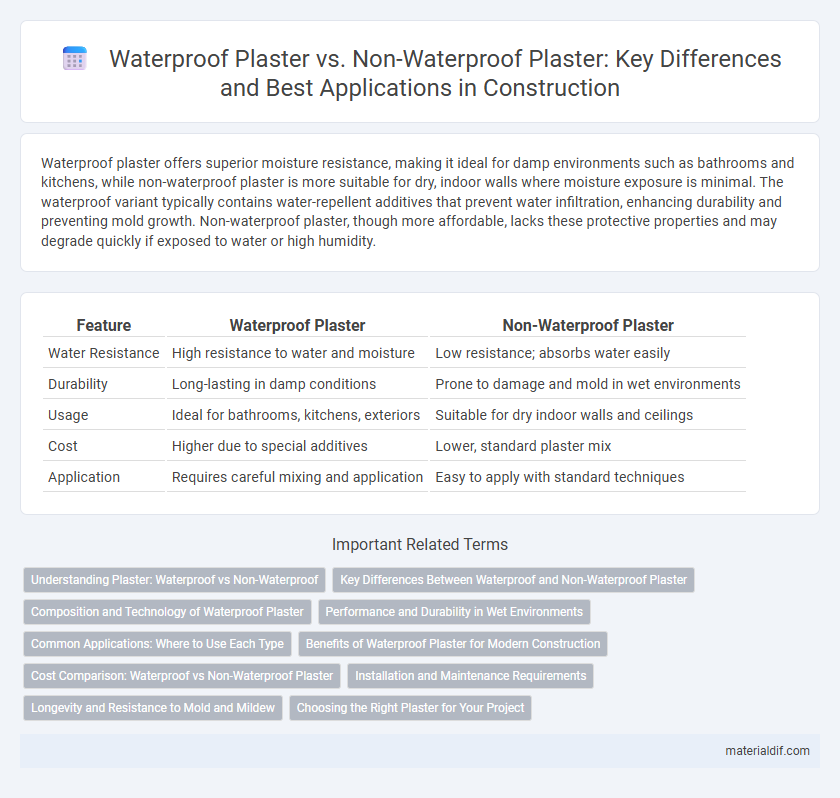Waterproof plaster offers superior moisture resistance, making it ideal for damp environments such as bathrooms and kitchens, while non-waterproof plaster is more suitable for dry, indoor walls where moisture exposure is minimal. The waterproof variant typically contains water-repellent additives that prevent water infiltration, enhancing durability and preventing mold growth. Non-waterproof plaster, though more affordable, lacks these protective properties and may degrade quickly if exposed to water or high humidity.
Table of Comparison
| Feature | Waterproof Plaster | Non-Waterproof Plaster |
|---|---|---|
| Water Resistance | High resistance to water and moisture | Low resistance; absorbs water easily |
| Durability | Long-lasting in damp conditions | Prone to damage and mold in wet environments |
| Usage | Ideal for bathrooms, kitchens, exteriors | Suitable for dry indoor walls and ceilings |
| Cost | Higher due to special additives | Lower, standard plaster mix |
| Application | Requires careful mixing and application | Easy to apply with standard techniques |
Understanding Plaster: Waterproof vs Non-Waterproof
Waterproof plaster contains additives such as polymers or silicone to create a moisture-resistant barrier, making it ideal for bathrooms, kitchens, and exterior walls exposed to water. Non-waterproof plaster, typically gypsum or lime-based, offers excellent breathability but lacks protection against water infiltration, leading to potential damage in damp environments. Choosing between waterproof and non-waterproof plaster depends on the specific application, environmental exposure, and desired durability of the surface.
Key Differences Between Waterproof and Non-Waterproof Plaster
Waterproof plaster contains additives such as polymers or silicone that create a water-resistant barrier, preventing moisture penetration and mold growth, making it ideal for wet areas like bathrooms and kitchens. Non-waterproof plaster lacks these additives, resulting in higher porosity and susceptibility to water damage, making it suitable for dry, indoor walls. The key difference lies in their moisture resistance properties, affecting durability and application suitability.
Composition and Technology of Waterproof Plaster
Waterproof plaster incorporates hydrophobic additives such as silicone or acrylic polymers that create a moisture-resistant barrier, unlike traditional non-waterproof plaster composed mainly of gypsum or lime which absorbs water. Advanced waterproof plaster employs nanotechnology and polymer modification to enhance durability and prevent water penetration, improving longevity in damp environments. This technology transforms the plaster's microstructure, reducing porosity and increasing resistance to mold and efflorescence.
Performance and Durability in Wet Environments
Waterproof plaster offers superior resistance to moisture penetration, preventing mold growth and structural damage in wet environments, while non-waterproof plaster tends to absorb water, leading to deterioration and reduced longevity. The performance of waterproof plaster is enhanced by additives like hydrophobic agents, which create a barrier against humidity and water exposure, ensuring durability in bathrooms, kitchens, and exterior walls. Non-waterproof plaster, although suitable for dry areas, lacks these protective properties, resulting in frequent repairs and compromised surface integrity when exposed to moisture over time.
Common Applications: Where to Use Each Type
Waterproof plaster is ideal for moisture-prone areas such as bathrooms, kitchens, and exterior walls, preventing water penetration and mold growth. Non-waterproof plaster is suitable for dry, interior spaces like living rooms and bedrooms where moisture resistance is not critical. Choosing the right plaster type ensures durability and maintains structural integrity in specific environmental conditions.
Benefits of Waterproof Plaster for Modern Construction
Waterproof plaster offers superior moisture resistance, making it ideal for modern construction projects exposed to high humidity or frequent water contact. Its ability to prevent water infiltration enhances wall durability, reduces mold growth, and minimizes structural damage over time. This results in lower maintenance costs and improved indoor air quality, essential for sustainable building practices.
Cost Comparison: Waterproof vs Non-Waterproof Plaster
Waterproof plaster generally costs 20-40% more than non-waterproof plaster due to added materials like polymers and water-resistant additives. Non-waterproof plaster is less expensive but may require more frequent repairs and maintenance in moisture-prone areas, increasing long-term expenses. Investing in waterproof plaster reduces potential damage and maintenance costs, offering better value in humid or wet environments.
Installation and Maintenance Requirements
Waterproof plaster requires careful surface preparation and the application of moisture-resistant primers to ensure proper adhesion and effectiveness, while non-waterproof plaster can be applied directly on clean, dry surfaces without additional treatments. Maintenance for waterproof plaster involves regular inspection for cracks or damage to retain its protective qualities, whereas non-waterproof plaster demands more frequent repairs and repainting due to its susceptibility to water damage. Installation of waterproof plaster is generally more complex and time-consuming but offers long-term durability in damp environments compared to the simpler installation of non-waterproof plaster.
Longevity and Resistance to Mold and Mildew
Waterproof plaster significantly extends the longevity of surfaces by preventing water penetration, which reduces the risk of structural damage over time. Its resistance to mold and mildew is superior compared to non-waterproof plaster, as the impermeable barrier inhibits moisture accumulation that fosters fungal growth. Non-waterproof plaster, while suitable for dry environments, is more susceptible to cracking and biological deterioration due to its porous nature.
Choosing the Right Plaster for Your Project
Waterproof plaster offers superior resistance to moisture, making it ideal for bathrooms, kitchens, and exterior walls where dampness is a concern. Non-waterproof plaster is suitable for dry, interior surfaces due to its ease of application and cost-effectiveness. Choosing the right plaster depends on the specific environmental conditions and durability requirements of your project.
Waterproof Plaster vs Non-Waterproof Plaster Infographic

 materialdif.com
materialdif.com